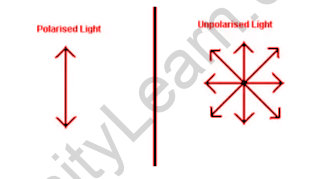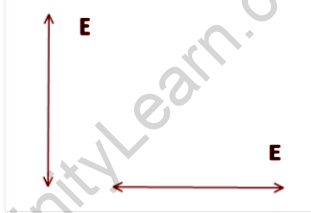Table of Contents
A light wave could be an electromagnetic wave that travels through the vacuum of outer space. light waves are made by moving electric charges. An electromagnetic wave is a transversal wave that has an electrical and a magnetic component.
A light wave that’s vibrating in additional than one plane is observed as unpolarized light. lightweight emitted by the sun, by a lamp within the classroom, or by light is unpolarized light. Such light waves are created by electric charges that vibrate during a type of direction, therefore making an electromagnetic wave that vibrates in a variety of directions. this idea of unpolarized lightweight is quite troublesome to visualize.
In general, it’s useful to image unpolarized light as a wave that has a mean of half its vibrations during a horizontal plane and half its vibrations in a vertical plane.
it’s possible to remodel unpolarized light into polarized light. Polarized light waves are light waves within which the vibrations occur in a single plane. the method of reworking unpolarized light into polarized light is understood as polarization.
Types of Polarization
Here are the three types of polarization based on transverse and longitudinal wave motion:
- Linear polarization
- Circular polarization
- Elliptical polarization
Linear Polarization
The electric field of light propagates in only one plane in linear polarization.
Circular Polarization
An electric field of light is composed of two linear components that are perpendicular to one another, but their phase differences are equal. The motion of the electric field thus causes it to propagate in a circular manner.
Elliptical Polarization
Light propagates along an elliptical path. Different linear components exhibit different amplitudes and phases.
Polaroid Films
Electromagnetic fields can be thought of as sinusoidal oscillations of light. Magnetic and electric fields are perpendicular to each other and to the direction of propagation. Perpendicular to the two fields, the pointing vector indicates the propagation direction:
S = 1/μ E × B
The electric field may be the same to be oscillatory on a plane perpendicular to S
However, there are infinitely several such planes, and light-weight that contains fields randomly distributed along of these planes are said to be unpolarized as shown. Since the electrical fields can be vectorially resolved at the side of any perpendicular directions, the illustration of unpolarized light can be shown on the right.

As shown below, plane polarised light contains light with an electric field (and thus a magnetic field) along only one plane:

What is the Plane of Polarization?
Polarizable filters produce polarized light from unpolarized light by selectively allowing electric fields (and thus magnetic fields) along a single plane known as the plane of polarization.
What is Polarizing Direction?
The direction of the electric field upon polarization is known as the polarizing direction.
Polarizing Sheets:
Polarizing sheets or polarizing filters are commercially referred to as polaroids. These sheets contain long-chain molecules that are aligned to permit field of force oscillations in just one direction. Early polarizing sheets comprised of aligned crystals embedded in plastics. Today, specially treated organic molecules in films are used a lot of unremarkably as polarizing sheets. The direction in which the filter polarizes light is its polarizing direction.
The intensity of absolutely unpolarized happen upon passing through a polarizing sheet is half the first intensity i.e, I = 1/2I0
If a filter encounters plane-polarized light at an angle Ө to its polarizing direction, only the component of the electric field along the polarizing direction is passed along ie: E = E0cosӨ
The intensity of an electric field is proportional to its square. Thus,
I ∝ E² = E0² Cos²Ө
I = I0Cos²Ө
The primary purpose of Polaroid is to reduce the intensity of light by using these filters.
What are Polaroids?
Polaroids are a type of optical filter that was invented by Edwin Land in 1928. They consist of a thin sheet of polarizing material that allows only light waves that are oriented in a particular direction to pass through while blocking all other waves. This unique property of polaroids has made them a useful tool in many different fields, including photography, physics, and optics.
The basic principle behind polaroids is polarization. Light is a form of electromagnetic radiation that travels in waves, and these waves vibrate in different directions as they move. When light waves are “polarized,” this means that they vibrate in a particular direction, creating a pattern of orientation in the electromagnetic field. Polarizing filters like polaroids are designed to block all light waves except for those that are vibrating in a specific direction.
Polaroids are often used in photography to reduce glare and improve image quality. When light reflects off of a shiny surface, such as water or glass, it becomes polarized in a particular direction. This can create a glare that can interfere with the quality of the photograph. By using a polarizing filter like a polaroid, photographers can block this polarized light and reduce or eliminate the glare, resulting in a clearer image.
Polaroids are also used in physics and optics to study the properties of light waves. By passing light through a polaroid and observing the changes in the orientation of the light waves, scientists can learn about the polarization properties of different materials and the interactions between light and matter.
In addition to their practical applications, polaroids have also become an iconic symbol of popular culture. They were often worn as sunglasses in the 1960s and 70s, and their distinctive design has been used in fashion and design to create a retro aesthetic.
Uses of polaroids and Plane Polarized Light
Polaroids are skinny plastic-like sheets, consisting of long-chain molecules aligned in a very specific direction. the electrical vectors (associated with the propagating light wave) in the direction of the aligned molecules get absorbed. It transmits light solely in one direction of the electric vector referred to as the pass axis and thereby the intensity of sunshine decreases.
Uses of Polaroid:
- Polaroids are employed in the laboratory to supply and analyze plane polarised light.
- Polaroids are widely used as polarizing sunglasses.
- They’re accustomed eliminate the light glare in the motor.
- They are accustomed improve color contrasts in recent oil paintings.
- Polaroid films are used in photographic cameras and 3D picture cameras.
- They’re used as glass windows in trains and airplanes to manage the intensity of light.
FAQs:
How does polarizer work?
A linear polarizer transmits light uniformly vibratory in a very single plane whereas interesting is the orthogonal plane. we tend to typically describe one plane or beam of polarized light in terms of what we decide the pattern of vibration. If the vibrations are in one direction, the light is linearly polarized.
Does polarization affect light intensity?
Light intensity is the same in spite of polarization but if unpolarized light, similar to daylight or typical light bulb light, is more established a polarizer than solely 50% of the intensity goes thorough because the partner has been blocked.








